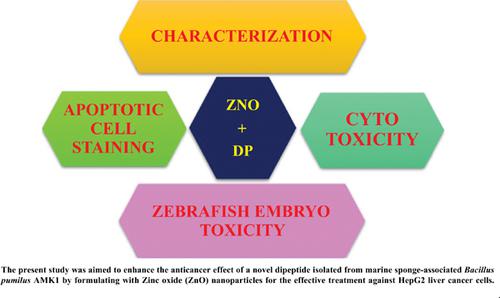Current Analytical Chemistry ( IF 1.7 ) Pub Date : 2021-05-31 , DOI: 10.2174/1573411016666200106101109 Gayathri Karanam 1 , Arumugam Madan Kumar 1 , Chinmai Sriamulya Yerukalapudi 1 , Nagabhishek Sirpu Natesh 1 , Rajender Boddula 2 , Ramyakrishna Pothu 3

|
Background: Nanomaterials-based cancer therapy plays a significant role in increasing the therapeutic efficiency of anticancer drugs, reducing side effects and targeted delivery of the drug payloads. The present study was aimed to enhance the anticancer effect of a novel dipeptide isolated from marine sponge-associated Bacillus pumilus AMK1 by formulating with Zinc oxide (ZnO) nanoparticles for the effective treatment against HepG2 liver cancer cells.
Methods: ZnO nanoparticles were synthesized by chemical method and size of the nanoparticle was characterized by Scanning electron microscope, X-Ray diffraction and Fourier-transform infrared spectroscopy. Furthermore, ZnO nanoparticles were conjugated with the isolated dipeptide and evaluated for anticancer activity. In addition, distinct morphological changes were observed by performing apoptotic staining methods such as propidium iodide staining and acridine orange/ ethidium bromide staining. Furthermore, embryotoxic and teratogenic effects of conjugated dipeptide on the development of zebrafish embryo were investigated in this study.
Results: It was observed that conjugated dipeptide showed enhanced cytotoxicity against HepG2 liver cancer cells without any toxic effect on normal liver cells. ZnO with dipeptide showed significant higher apoptosis of liver cancer cells, with around 19% in early apoptosis and 53% in late apoptosis stage. The obtained results suggest that ZnO nanoparticle conjugated dipeptide initiated cytotoxicity through apoptotic death in HepG2 cells. The embryotoxic studies in zebrafish embryos revealed the LC50 197.0 μg/mL. These findings suggest that conjugated dipeptide affected the development of zebrafish embryos only at relatively higher concentrations.
Conclusion: The experimental results demonstrate that ZnO nanoparticle conjugated dipeptide has the potential to improve anticancer efficacy against liver cancer cells by inducing apoptosis in cancer cells without any effect on normal liver cells.
中文翻译:

纳米氧化锌与海洋海绵衍生的二肽的结合增强肝癌细胞的抗癌作用及其对斑马鱼胚胎的毒性评价
背景:基于纳米材料的癌症治疗在提高抗癌药物的治疗效率,减少副作用和有效药物靶向递送方面起着重要作用。本研究旨在通过与氧化锌(ZnO)纳米粒子配合配制,从海洋海绵相关的短小芽孢杆菌AMK1中分离出新型二肽,以有效治疗HepG2肝癌细胞的抗癌作用。
方法:采用化学方法合成了ZnO纳米粒子,并通过扫描电子显微镜,X射线衍射和傅里叶变换红外光谱对纳米粒子的尺寸进行了表征。此外,将ZnO纳米颗粒与分离的二肽偶联,并评估其抗癌活性。另外,通过进行凋亡染色方法,例如碘化丙啶染色和a啶橙/溴化乙锭染色,观察到明显的形态变化。此外,在这项研究中研究了共轭二肽对斑马鱼胚胎发育的胚胎毒性和致畸作用。
结果:观察到缀合的二肽显示出对HepG2肝癌细胞的增强的细胞毒性,而对正常肝细胞没有任何毒性作用。带有二肽的ZnO表现出肝癌细胞明显更高的凋亡,早期凋亡约为19%,晚期凋亡约为53%。获得的结果表明,ZnO纳米颗粒结合的二肽通过HepG2细胞的凋亡死亡而引发细胞毒性。斑马鱼胚胎的胚胎毒性研究显示LC50为197.0μg/ mL。这些发现表明,缀合的二肽仅在相对较高的浓度下影响斑马鱼胚胎的发育。
结论:实验结果表明,ZnO纳米粒子共轭二肽具有诱导肝癌细胞凋亡的作用,而对正常肝细胞没有任何影响,因此具有提高抗肝癌细胞疗效的潜力。











































 京公网安备 11010802027423号
京公网安备 11010802027423号